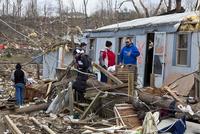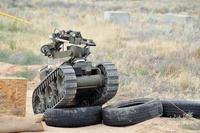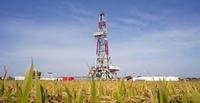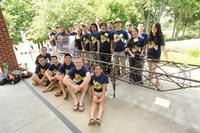-
Smart technologies tackle global food shortage
From monitoring soil moisture to measuring oyster heartbeats, Aussie farmers can help to tackle the global food shortage and significantly increase their productivity by taking advantage of new smart farming technologies enabled by next generation broadband networks.
-
-
Bolstering pre-disaster resilience significantly reduces post-disaster recovery cost
A new study finds that the federal government spends six times more on post-disaster disaster recovery efforts than on helping communities become more resilient to extreme weather which is predicted to become more intense and frequent. The study, citing Federal Emergency Management Agency (FEMA) estimates, calculates that for every $1 invested in “pre-disaster” mitigation, the cost of damage from extreme weather is reduced by $4.
-
-
$110 billion in damages makes 2012 second only to 2005 in terms of weather-related disasters

The U.S. National Climatic Data Center’s (NCDC) says that 2012 saw eleven weather and climate disaster events each with losses exceeding $1 billion in damages. This makes 2012 the second costliest year since 1980, with a total of more than $110 billion in damages throughout the year. The 2012 total damages rank only behind 2005, which incurred $160 billion in damages due in part to four devastating land-falling hurricanes.
-
-
USDA announces additional emergency watershed protection funding
USDA’s Natural Resources Conservation Service will send an additional $66.8 million in Emergency Watershed Protection Program funds to help disaster recovery efforts in fifteen states.
-
-
Highly conductive textiles allow for wearable electronics

Jackets with built-in mobile phones, sports clothes that warn you when your heart rate gets too high, wallpaper with glowing patterns — these may appear like concepts from a science fiction movie, but some of them are actually already available, and they may soon become commonplace.
-
-
Storm predictions for Navy, civilian planners
With the arrival of the Atlantic hurricane and Pacific typhoon season, and the often dangerous storms that can accompany it, new technology sponsored by the Office of Naval Research (ONR) will be used to help Navy and civilian officials alike plan for stormy weather, officials announced the other day.
-
-
Weather reports aid life-or-death decisions in Africa
The people living in sub-Saharan Africa have a life-or-death dependency on information about the weather. Knowing when, where, and what to grow or graze animals can be the difference between a bumper harvest and facing starvation. Although sub-Saharan Africa depends more directly on rainfall than any other region on Earth, the region has the fewest number of rain monitoring stations. There are also significant delays in the time between measurements being made and the resulting data being made available.
-
-
Testing the seismic strength of light frame steel construction
A partnership of leading earthquake engineering researchers from top U.S. and Canadian universities and design professionals from the steel industry have begun the final phase of a three-year project to increase the seismic safety of buildings that use lightweight cold-formed steel for their primary beams and columns. Research to conclude with shake-table testing.
-
-
Sandia hosts annual Robot Rodeo

Sandia National Laboratories is hosting the seventh annual Western National Robot Rodeo and Capability Exercise, a lively and challenging five-day event that draws civilian and military bomb squad teams from across the country to see who can most effectively defuse dangerous situations with the help of robots.
-
-
Risk assessment of shale gas fracking to biodiversity

Fracking, the controversial method of mining shale gas, is widespread across Pennsylvania, covering up to 280,000 km² of the Appalachian Basin. New research explores the risks posed to biodiversity including pollution from toxic chemicals, the building of well pads and pipelines, and changes to wetlands.
-
-
New Jersey faces costly water infrastructure upgrades

Before Hurricane Sandy hit New Jersey, state officials knew they had much work ahead of them to update the state’s water infrastructure. The damage Sandy inflicted only highlighted the inadequacies of New Jersey’s outdated wastewater, stormwater, and drinking water infrastructure. Upgrading the system will be costly, but not doing so will be costlier.
-
-
Improving close air support for faster, more precise airstrikes
Air-ground fire coordination — also known as Close Air Support or CAS — is a dangerous and difficult business. While its tools have become more sophisticated, CAS has not fundamentally changed since the First World War. Now, Persistent Close Air Support (PCAS) program aims to improve air-to-ground fire coordination, but could revolutionize military technology development and deployment as well.
-
-
U California, Berkeley students win National Student Steel Bridge Competition

The weekend of 31 May residents of Washington State watched as engineers began erecting a temporary steel bridge over the Skagit River, to replace the 160-foot span of a 4-lane bridge that had collapsed a week earlier, after being struck by an over-height truck. Just sixty miles away, on the campus of the University of Washington in Seattle, 620 civil engineering students erected their own temporary steel bridges in a competition to demonstrate their engineering skills. For the second consecutive year and for the second time in the past seven years, a team of students from the University of California, Berkeley captured the title as champions of the ASCE/AISC National Student Steel Bridge Competition (NSSBC).
-
-
Israel taps 10th graders’ cybersecurity skills to expand cybersecuity recruitment pool
Israel has been subjected to a growing number of cyberattacks – and has itself used cyber-warfare against its adversaries. To make sure it stays ahead, Israel is accelerating its recruitment and development efforts in cybersecurity. Among other initiatives, the country is expanding the pool of potential cyberwarriors by going into high school classrooms to tap the cyber skills of tenth-graders.
-
-
Detecting explosives, not toothpaste
Researchers want airports, border checkpoints, and others to detect homemade explosives made with hydrogen peroxide without nabbing people whose toothpaste happens to contain peroxide. This is part of the challenge faced in developing a portable sensor to detect a common homemade explosive called a FOx (fuel/oxidizer) mixture, made by mixing hydrogen peroxide with fuels.
-
More headlines
The long view
New Technology is Keeping the Skies Safe
DHS S&T Baggage, Cargo, and People Screening (BCP) Program develops state-of-the-art screening solutions to help secure airspace, communities, and borders
Factories First: Winning the Drone War Before It Starts
Wars are won by factories before they are won on the battlefield,Martin C. Feldmann writes, noting that the United States lacks the manufacturing depth for the coming drone age. Rectifying this situation “will take far more than procurement tweaks,” Feldmann writes. “It demands a national-level, wartime-scale industrial mobilization.”
How Artificial General Intelligence Could Affect the Rise and Fall of Nations
Visions for potential AGI futures: A new report from RAND aims to stimulate thinking among policymakers about possible impacts of the development of artificial general intelligence (AGI) on geopolitics and the world order.
Smaller Nuclear Reactors Spark Renewed Interest in a Once-Shunned Energy Source
In the past two years, half the states have taken action to promote nuclear power, from creating nuclear task forces to integrating nuclear into long-term energy plans.
Keeping the Lights on with Nuclear Waste: Radiochemistry Transforms Nuclear Waste into Strategic Materials
How UNLV radiochemistry is pioneering the future of energy in the Southwest by salvaging strategic materials from nuclear dumps –and making it safe.
Model Predicts Long-Term Effects of Nuclear Waste on Underground Disposal Systems
The simulations matched results from an underground lab experiment in Switzerland, suggesting modeling could be used to validate the safety of nuclear disposal sites.
